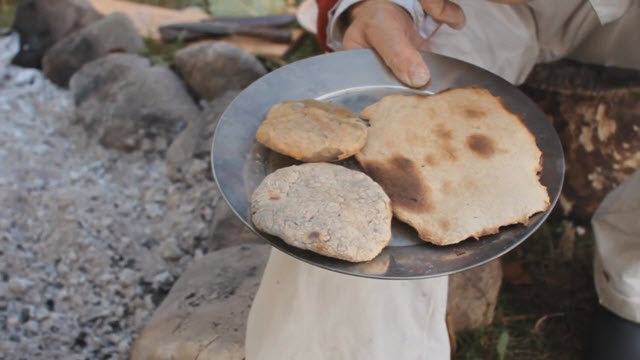
It was very common for soldiers in the 18th century, especially when they were on the march, to be issued their rations several days ahead of time. They would be issued several days of their bread ration, and because they would be gone for a while, they would likely be given just flour as bread would just go bad. They were also on the march with very little equipment to use as well and all they had was flour and they would have to make some kind of food with it. Today we’re going to make fire cake or ash cake, a very, very simple thing that the soldiers would be able to make with just the flour and a little bit of water.
- Flour
- Water
- Salt (optional)
- Hot Coal Bed
- Bannock Board or flat half split of firewood(optional)
- Large Leaves such as Grape or Cottonwood (optional)
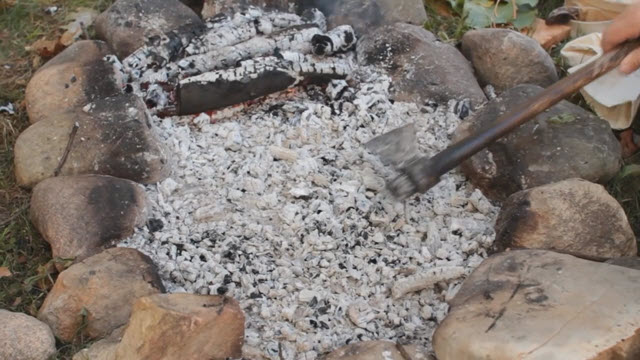
First we’re going to need to have good ashes. We’re going to have to have a good and hot ash bed to work with. The ash bed that you’re cooking on is really important. If your ashes are grey, they’re probably already too cool to do any cooking on.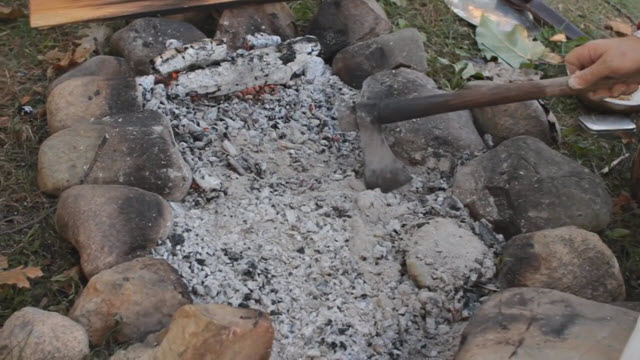
You want white hot ash, it’s really warm. That’s the kind of ash we’re cooking with. The stuff that’s still white.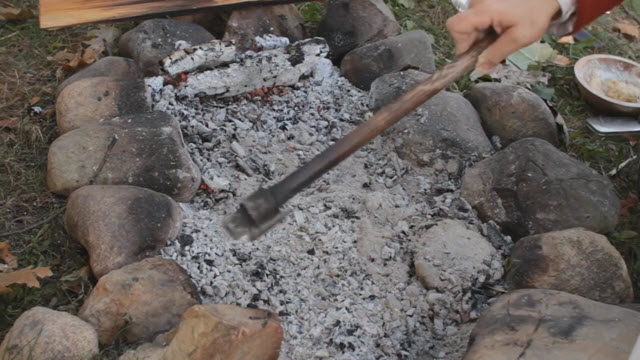
If it’s grey, it’s gotten too cold to cook with.
Next, let’s make up our dough. I’ve got a simple wooden bowl here for us to make our dough in, the flour that we’ve been issued, and I’m going to make up 3 or 4 ash cakes here.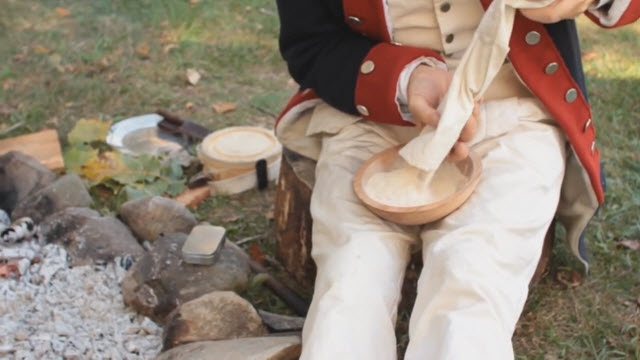
If you have any salt, available to you, which the soldiers may or may not have had salt that day or that particular time, but salt will add a lot to the taste of your fire cake, so in this case we are going to add a good bit of salt to it, and we’re going to stir that around while our ingredients are still dry so it will be easy to mix. And now we’re going to need some water. We add enough water to make a stiff paste, and we’re going to start out with maybe a little less than we need so that we don’t go overboard.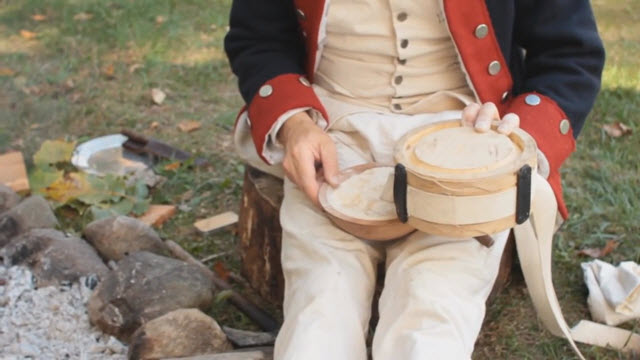
If you are going to cook on the bannock board, the dough needs to be a little stickier, because we need to stick it to the board.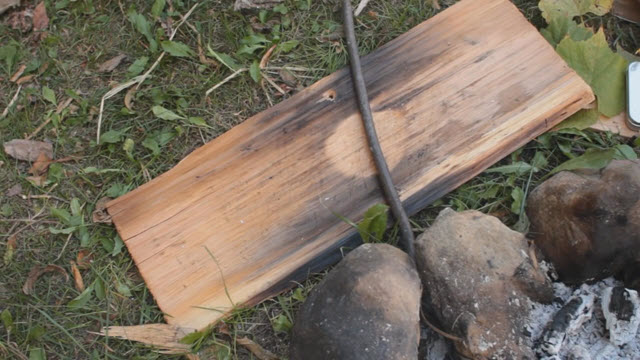
It needs to stay there while it’s cooking. Flatten it out on the bannock board nice and thin. The thinner it is the better it’s going to cook.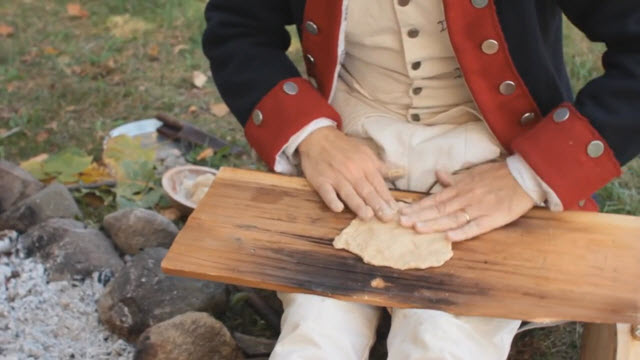
Our board has two holes in it so that we can prop it up.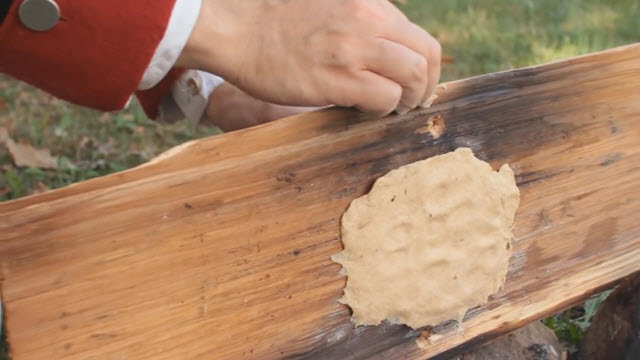 About halfway through cooking, when the bottom turns brown, rotate the board so that the top can cook.
About halfway through cooking, when the bottom turns brown, rotate the board so that the top can cook.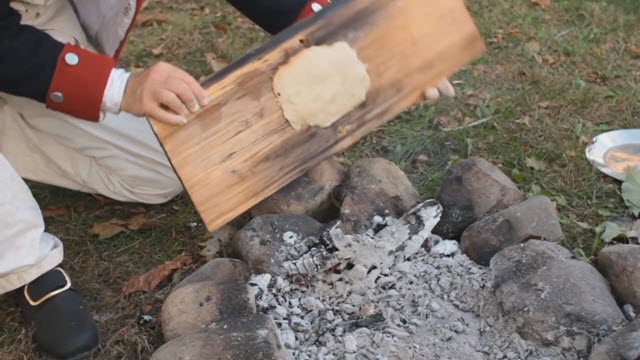
Your bannock board fire cake is ready to pull off when it’s browned up all over on the outside.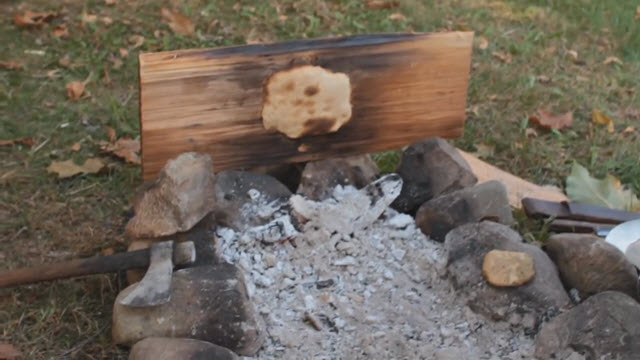
It may be tough to get off, but you should see it’s still a little damp on one side and cooked completely on the other.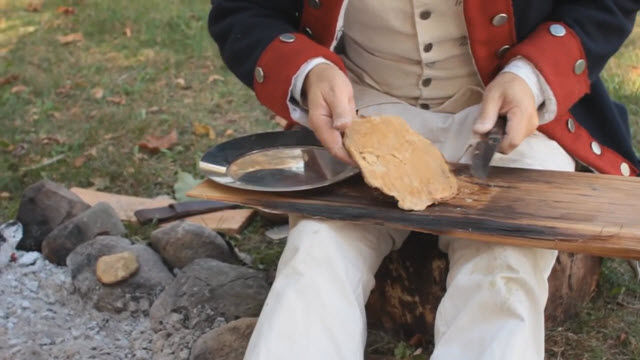
If you do not have a bannock board, but you can acquire some large leaves, we can cook our ash cakes another way. Depending on the time of year, different leaves are going to work better than others, but you want a nice big leaf that’s going to protect your cake.
Be aware that the closer to the cake the leaves are, the more of its flavor is going to transfer to the cake, so grape is best. Make your dough into a thin patty, about a quarter of an inch or so, and about the size of the leaves. Carefully wrap your patty in several layers of leaves, because they will slowly burn though. Place the patty in a nice hot section of coals and gently cover with more hot coals.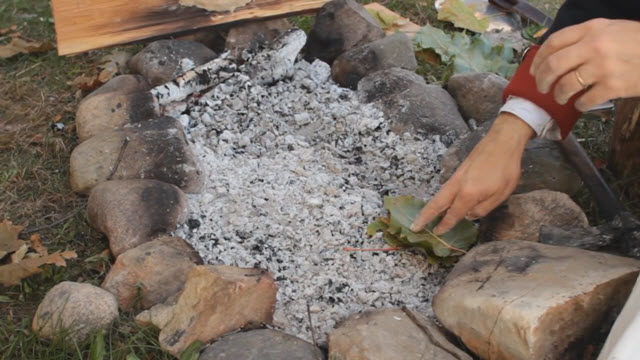
This will only take about 3-5 minutes to cook, but you will have to use your best judgement, because it is not something you can time. The more experience you gain with this the easier it will be to tell when it is ready to come out. When you feel it is time to remove your patty, gently scrape off the ashes and remove the leaves.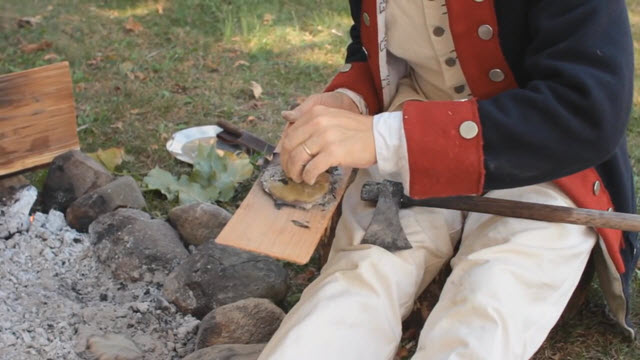
If you feel that it is not done yet but it is still hot, simply set it aside for a few minutes and it will continue to cook a little bit on the inside.
Finally, if you do not have bannock board or access to large leaves, you can just put your cake straight into the coals.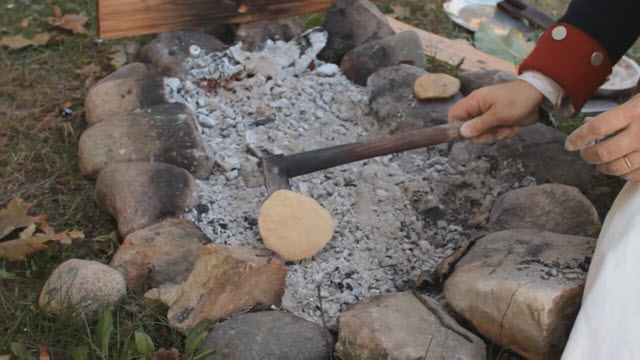
A little bit of ash is known to calm your digestive tract so the ash isn’t going to hurt you a bit. Make your thin patty just as if you are going to cover it in leaves and then simply place it in the coal bed and gently cover with hot coals making sure not to lose it in the fire. 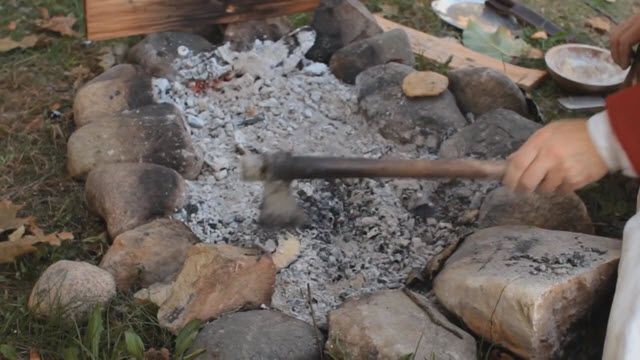
After a few minutes when you feel that it is ready, carefully remove the coals. Some of the coals may be stuck to your ash cake and may still be very hot.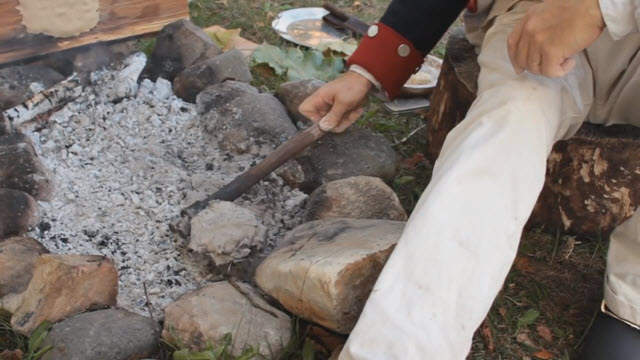
So there you have it. You’ve got the three different kinds of ash cake or fire cake. We’ve got our bannock board cake, the one we cooked right in the ashes and then the one we used the leaves for protection. Definitely very edible, I think I’ll have them for supper tonight.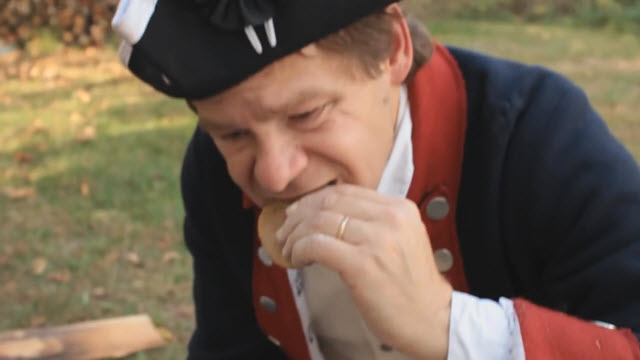
Transcript of Video:
It’s very common for soldiers in the 18th century, especially when they were on the march, they’d be issued their rations, maybe several days ahead of time they’d be issued several days of meat and then they’d be issued their flour or their bread ration, and because they would be gone for a while they would likely be given just flour instead of bread as that would just go bad and so there they were on the march with not very much equipment to use and all they had was flour and they would have to make some kind of food with it. Today we’re going to make fire cake or ash cake, a very, very simple thing that the soldiers would be able to make with just the flour and a little bit of water.
So what are we going to need to make ash cake? Well, number one we’re going to need to have good ashes. We’re going to have to have a really nice ash bed to work with, good and hot. So we don’t have very much equipment. We’re going to try to do this with three different methods. We’re going to use a simple bannock board, or if you don’t have a board like this, maybe you could just use a half split of firewood that’s nice and flat. We’re also going to use a method where we put leaves around our fire cake or ash cake and so all you’re going to need for that is some large leaves like a grape leaf or a large tree leaf, burdock or cabbage leaves, something like that. And the last method, we’re not going to use anything at all, we’re just going to make our cake and we’re going to place them right on the coals.
So, now our coals are getting really close to being ready to use. Let’s make up our dough. I’ve got a simple wooden bowl here for us to make our dough in, the flour that we’ve been issued, and I’m going to make up 3 or 4 ash cakes here. If you have any salt, available to you, which the soldiers may or may not have had salt that day or that particular time, but salt will add a lot to the taste of your fire cake, so in this case we are going to add a good bit of salt to it, and we’re going to stir that around while our ingredients are still dry so it will be easy to mix. And now we’re going to need some water. We add enough water to make a stiff paste, and we’re going to start out with maybe a little less than we need so that we don’t go overboard. For the ash cakes that we’re going to cook on the bannock board, we’re going to get this to be a little stickier because we need to stick it to the board. It needs to stay there while it’s cooking.
Okay, we’ve got our dough mixed up. It’s nice and the right kind of consistency, a little stiff but still sticky enough to work with and I’ve got this. We’re going to take this one and we’re going to flatten it out on our bannock board, going to get it nice and thin. The thinner, the better it’s going to cook. We need to make sure that it’s sticky enough that it sticks to the board. Our board has two holes in it so that we can prop it up. Let’s put this up by the fire and let this cook while I’m working on the other ones.
Okay, we’ve got the fire banked up a little bit higher on this spot and I’m going to place the board, I don’t want to get it too close so it catches on fire, but I can feel the heat here, that feels pretty good. I’ve got our little stick here to prop it up at an angle, and that feels really good. We’re going to let that cook.
Let’s use leaves for our next fire cakes. I’m going to keep watching that one and make sure it doesn’t burn, but here’s our next fire cake. Let’s take out a dough section here, and we’re going to make it into a patty. We’re not making it as thin as that but, you know, thinish. We’re going to make it in relationship to the size of our leaves. I’ve got here some wild grape leaves and some cottonwood leaves, depending on the time of year, you know, different leaves are going to work better than other ones but you want a nice big leaf that’s going to protect your fire cake, so let’s use our grape leaf on the inside because I want a bit of the taste. It does end up on the fire cake. We’re going to put grape leaves on the inside and then a little extra protection, because the leaves are going to slowly burn through, we’re going to put the cottonwood leaves on, and I’ve got a really nice coal section here, we’re just going to place this right onto the coals. Since it’s got the coals right on top and below it, it’s not going to take that long to cook, 3, or 4, maybe 5 minutes. That’s something you’re going to judge, you’re not going to be able to tell, so it takes a little experience to know when it’s ready to come out. The ash bed is really important that you’re cooking on. If your ashes are grey, they’re probably already too cool to do any cooking on, like this color. This white hot ash over here, it’s really warm, that’s the kind of ash we’re cooking with. The stuff that’s still white. If it’s grey, it’s gotten too cold to cook with.
Our bannock board biscuit looks like it still needs a little bit of time to cook. I’ll have to turn it over pretty shortly, but this one’s probably ready to come out. It’s been about 4 minutes or so. I’m just going to lightly scrape off our ashes from the top and scoop the whole patty out. There it is. Let’s put it on top of this board so we can see how it turned out. There we are. It feels like this one’s just about done. I could have probably left it in about another minute or two but it’s still hot, it’s still cooking so I’m just going to go ahead and set this off to the side where it will stay warm, but it’s still hot so it’s still cooking on the inside.
Our bannock board fire cake over here, you can see it’s starting to brown up along the bottom side so I’m going to go ahead and rotate the board so the other side, the top side of it, can cook. You want to be really gentle when we turn this over so we don’t knock the bread off, and I’m going to tilt this a little bit further because our coals are getting a little bit cooler, but they’re still really warm right there, so it should cook right up.
Well, let’s try our fire cake where we actually put it directly on the coals. If you don’t have good leaves to work with you can just try cooking our fire cake right on the coals. It’s going to char up on the outside but that’s all we have to work with so let’s do it. We’re going to place it right on the coals here. I’ve got a nice hot section of coals and we’ll place it right on there. I’m going to use my tomahawk because this fire is hot. There we go, and I’m going to find some hot coals close by and we’re going to set them on top, lightly and gently bury it in the hot coals. I’m not going to bury it completely. I don’t want to lose it in the fire. I want to be able to see around the edges just a little bit so I can watch it cooking.
Well, it looks like our bannock board fire cake is ready to pull off. It’s browned up all over on the outside so we’re going to go ahead and pull this off the board and put it onto our plate. This may be tough to get off, but this one came off, now you can see it’s still a little damp on that side, cooked completely on that side. I call that done.
Well, our bannock bread’s off, the other one’s out, it smells like our ash cake that’s cooking right here in the coals is probably ready to pull out too, so let’s pull it out with that, dust the ashes off the top. We’ve still got some that are sticking to the bottom, gently, might still be hot coals, so I’m not going to touch them. A little bit of ash is known to calm your digestive tract so the ash isn’t going to hurt you a bit, and it looks really good for cooking right there in the coals.
So there you have it. You’ve got the three different kinds of ash cake or fire cake. We’ve got our bannock board cake, the one we cooked right in the ashes and then the one we used the leaves for protection. Let’s try these out. Definitely very edible, I think I’ll have them for supper tonight. Any of these things you’ve seen here you can see on our website or in our print catalog and don’t forget to follow us on Facebook.

